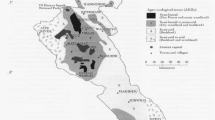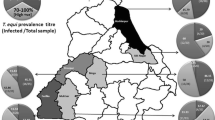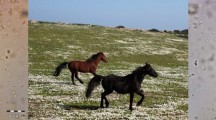Abstract
Theileria equi (Laveran 1901) and Babesia caballi (Nuttall and Strickland 1910) are the causative agents of Equine Piroplasmosis (EP), a severe and problematic disease compromising international movement of horses. Infected horses usually become asymptomatic carriers and, for this reason, their movement across borders may become restricted. The aim of this study was to assess the seroprevalence of EP in Southern France and to evaluate risk factors associated with these parasites. In 2002, we performed a complement fixation test (CF) with blood samples from 443 horses stabled at 95 different farms located in the region of Camargue. Two epidemiological questionnaires have been used: one for each single horse (individual and management factors) and one for each place where horses were sampled (environment, presence of other species, etc.) to identify risk factors for seropositivity. T. equi and B. caballi had a seroprevalence of 58 % and 12.9 %, respectively. For T. equi, sex, age, activity, management, and living with or near cattle were identified as risk factors, while for B. caballi, only living in wetlands was recognized as a risk factor in the bivariate analysis. In the multivariate analysis, the best model for T. equi included as variables age, breed, and deworming, while the best model for B. caballi included the type of housing during day and the contact with cows.




Similar content being viewed by others
References
Abutarbush SM, Alqawasmeh DM, Mukbel RM, Al-Majali AM (2012) Equine Babesiosis: seroprevalence, risk factors and comparison of different diagnostic methods in Jordan. Transbound Emerg Dis 59(1):72–78
Acici M, Umur S, Guvenc T, Arslan HH, Kurt M (2008) Seroprevalence of equine babesiosis in the Black Sea region of Turkey. Parasitol Int 57(2):198–200
Adaszek L, Winiarczyk S (2008) Molecular characterization of Babesia canis canis isolates from naturally infected dogs in Poland. Vet Parasitol 152(3–4):235–241
Alhassan A, Iseki H, Kim C, Yokoyama N, Igarashi I (2007) Comparison of polymerase chain reaction methods for the detection of Theileria equi infection using whole blood compared with pre-extracted DNA samples as PCR templates. Trop Anim Health Prod 39(5):369–374
Asgarali Z, Coombs DK, Mohammed F, Campbell MD, Caesar E (2007) A serological study of Babesia caballi and Theileria equi in Thoroughbreds in Trinidad. Vet Parasitol 144(1–2):167–171
Bahrami S, Ghadrdan AR, Mirabdollahi SM, Fayed MR (2014) Diagnosis of subclinical equine theileriosis in center of Iran using parasitological and molecular methods. Trop Biomed 31(1):110–117
Bakheit MA, Seitzer U, Mbati PA, Ahmed JS (2007) Serological diagnostic tools for the major tick-borne protozoan diseases of livestock. Parassitol 49(Suppl 1):53–62
Bashiruddin J, Camma C, Rebelo E (1999) Molecular detection of Babesia equi and Babesia caballi in horse blood by PCR amplification of part of the 16S rRNA gene. Vet Parasitol 84(1–2):75–83
Battsetseg B, Mikami T, Ikadai H, Xuan X, Fujisaki K, Nagasawa H et al (2001) Detection of Babesia caballi and Babesia equi in Dermacentor nuttalli adult ticks. Int J Parasitol 31(4):384–386
Bautista JL, Ikadai H, You M, Battsetseg B, Igarashi I, Nagasawa H et al (2001) Molecular evidence of Babesia caballi (Nuttall and Strickland, 1910) parasite transmission from experimentally-infected SCID mice to the ixodid tick, Haemaphysalis longicornis (Neuman, 1901). Vet Parasitol 102(3):185–191
Brooker S, Hay SI, Bundy DAP (2002) Tools from ecology: useful for evaluating infection risk models? Trends Parasitol 18:70–74
Brüning A, Phipps P, Posnett E, Canning E (1997) Monoclonal antibodies against Babesia caballi and Babesia equi and their application in serodiagnosis. Vet Parasitol 68(1–2):11–26
Burnham KP, Anderson DR (2002) Model selection and multi-model inference: a practical information-theoretic approach, 2nd edn. Springer, New York
Butler CM, Sloet van Oldruitenborgh-Oosterbaan MM, Stout TAE, Van Der Kolk JH, Van den Wollenberg L et al (2012) Prevalence of the causative agents of equine piroplasmosis in the South West of The Netherlands and the identification of two autochthonous clinical Theileria equi infections. Vet J 193:381–385
Camacho AT, Guitian FJ, Pallas E, Gestal JJ, Olmeda AS, Habela MA et al (2005) Theileria (Babesia) equi and Babesia caballi infections in horses in Galicia, Spain. Trop Anim Health Prod 37(4):293–302
Carpenter TE (2001) Methods to investigate spatial and temporal clustering in veterinary epidemiology. Prev Vet Med 48(4):303–320
Chadoeuf J, Leblond A, Senoussi R (2004) Using inter-event functions for bandwidth selection in intensity estimation. Environmetrics 15:513–517
Chastagner J, (2012) Phylogenetic analysis of Anaplasma phagocytophilum strains identified from ticks, Camargue, France. Master Thesis, University Claude Bernard Lyon1, 22 pp.
Chastagner A, Bailly X, Leblond A, Pradier S, Vourche G (2013) Single genotype of Anaplasma phagocytophilum identified from ticks, Camargue, France. Emerg Infect Dis 19:825–826
Criado A, Martinez J, Buling A, Barba J, Merino S, Jefferies R et al (2006) New data on epizootiology and genetics of piroplasms based on sequences of small ribosomal subunit and cytochrome b genes. Vet Parasitol 142(3–4):238–247
Farkas R, Tanczos B, Gyurkovszky M, Foeldvari G, Solymosi N, Edelhofer R et al (2013) Serological and molecular detection of Theileria equi infection in horses in Hungary. Vet Parasitol 192(1–3):143–148
Friedhoff KT (1982) The piroplasms of equidae, significance for international commerce. Berl Munch Tierarztl Wochenschr 95:368–374
Friedhoff KT, Soule C (1996) An account on equine babesiosis. Rev Sci Tech 15:1191–1201
Friedhoff KT, Tenter AM, Muller I (1990) Haemoparasites of equines: impact on international trade of horses. Rev Sci Tech 9:1187–1194
Fritz D (2010) A PCR study of piroplasms in 166 dogs and 111 horses in France (March 2006 to March 2008). Parasitol Res 106(6):1339–1342
Garcia-Bocanegra I, Arenas-Montes A, Hernandez E, Adaszek Å, Carbonero A, Almeria S et al (2013) Seroprevalence and risk factors associated with Babesia caballi and Theileria equi infection in equids. Vet J 195(2):172–178
Grandi G, Molinari G, Tittarelli M, Sassera D, Kramer LH (2011) Prevalence of Theileria equi and Babesia caballi infection in horses from Northern Italy. Vector Borne Zoonotic Dis 11(7):955–956
Grause JF, Ueti MW, Nelson JT, Knowles DP, Kappmeyer LS, Bunn TO (2013) Efficacy of imidocarb dipropionate in eliminating Theileria equi from experimentally infected horses. Vet J 196(3):541–546
Hall CM, Busch JD, Scoles GA, Palma-Cagle KA, Ueti MW, Kappmeyer LS et al (2013) Genetic characterization of Theileria equi infecting horses in North America: evidence for a limited source of U.S. introductions. Parasit Vectors 6(1):35
Halos L, Bord S, Cotte V, Gasqui P, Abrial D, Barnouin J, Boulouis HJ, Vayssier-Taussat M, Vourche G (2010) Ecological factors characterizing the prevalence of bacterial tick-borne pathogens in Ixodes ricinus ticks in pastures and woodlands. Appl Environ Microbiol 76(13):4413–4420
Heim A, Passos LM, Ribeiro MF, Costa-Junior LM, Bastos CV, Cabral DD et al (2007) Detection and molecular characterization of Babesia caballi and Theileria equi isolates from endemic areas of Brazil. Parasitol Res 102(1):63–68
Heuchert C, Giulli D, Athaide DF Jr, Bose R, Friedhoff KT (1999) Seroepidemiologic studies on Babesia equi and Babesia caballi infections in Brazil. Vet Parasitol 85(1):1–11
Hirata H, Ikadai H, Yokoyama N, Xuan X, Fujisaki K, Suzuki N et al (2002) Cloning of a truncated Babesia equi gene encoding an 82-kilodalton protein and its potential use in an enzyme-linked immunosorbent assay. J Clin Microbiol 40(4):1470–1474
Ikadai H, Osorio CR, Xuan X, Igarashi I, Kanemaru T, Nagasawa H et al (2000) Detection of Babesia caballi infection by enzyme-linked immunosorbent assay using recombinant 48-kDa merozoite rhoptry protein. Int J Parasitol 30(5):633–635
Jongejan F, Uilenberg G (2004) The global importance of ticks. Parasitol 129(7):S3
Kappmeyer LS, Knowles DP, Gillespie JJ, Djikeng A, Caler E, Ramsay JD et al (2012) Comparative genomic analysis and phylogenetic position of Theileria equi. BMC Genomics 13(1):603
Karatepe B, Karatepe M, Cakmak A, Karaer Z, Ergun G (2009) Investigation of seroprevalence of Theileria equi and Babesia caballi in horses in Nigde province, Turkey. Trop Anim Health Prod 41(1):109–113
Kirkham WW (1969) The treatment of equine babesiosis. J Am Vet Med Assoc 155:457–460
Klinkmann G (1981) Sporozoitenstabilate von Babesia Equi aus Hyalomma Anatolicum and Rhipicephalus turanicus. PhD Thesis. West Germany: Tierarztliche Hochschule Nannover.
Knowles DP (1996a) Equine Babesiosis (piroplasmosis): a problem in the international movement of horses. Br Vet J 152(2):123–126
Knowles DP (1996b) Control of Babesia equi parasitemia. Parasitol Today 12(5):195–198
Kouam MK, Kantzoura V, Gajadhar AA, Theis JH, Papadopoulos E, Theodoropoulos G (2010a) Seroprevalence of equine piroplasms and host-related factors associated with infection in Greece. Vet Parasitol 169(3–4):273–278
Kouam MK, Masuoka PM, Kantzoura V, Theodoropoulos G (2010b) Geographic distribution modeling and spatial cluster analysis for equine piroplasms in Greece. Infect Genet Evol 10(7):1013–1018
Leblond A, Pradier S, Pittel PH, Fortier G, Boireau P et al (2005a) Enquete epidemiologique sur l'Anaplasmose Equine dans le Sud de la France. Rev Sci Tech 4:899–908
Leblond A, Zientara S, Chadouef J, Comby N, Heng MA et al (2005b) Prevalence de l'infection par le West Nile Virus chez le cheval en Camargue. Med Vet Entomol 156:77–84
Leblond A, Sandoz A, Lefebvre G, Zeller H et al (2007) Remote sensing-based identification of environmental risk factors associated with West Nile Virus circulation in Camargue, France. Prev Vet Med 79:20–31
Léger E, Vourche G, Vial L, Chevillon C, Mccoy KD (2013) Changing distributions of ticks: causes and consequences. Exp Appl Acarol 59(1–2):219–244
Mehlhorn H, Schein E (1984) The piroplasms: life cycle and sexual stages. Adv Parasitol 23:37–103
Mehlhorn H, Schein E (1998) Redescription of Babesia equi Laveran, 1901 as Theileria equi Mehlhorn, Schein 1998. Parasitol Res 84:467–475
Moretti A, Tampieri MP, Gabrielli S, Moretta I, Torina A, Scoccia E et al (2010) Prevalence and diagnosis of Babesia and Theileria infections in horses in Italy: a preliminary study. Vet J 184(3):346–350
Mujica FF, Perrone T, Forlano M, Coronado A, Melendez RD, Barrios N et al (2011) Serological prevalence of Babesia caballi and Theileria equi in horses of Lara State, Venezuela. Vet Parasitol 178(1–2):180–183
Munkhjargal T, Yokoyama N, Igarashi I, Terkawi MA, Byambaa B, Bayarsaikhan D et al (2013) Prevalence and genetic diversity of equine piroplasms in Tov province, Mongolia. Infect Genet Evol 16:178–185
Nagore D, Garcia-Sanmartin J, Garcia-Perez AL, Juste RA, Hurtado A (2004) Detection and identification of equine Theileria and Babesia species by reverse line blotting: epidemiological survey and phylogenetic analysis. Vet Parasitol 123(1–2):41–54
Ogunremi O, Georgiadis MP, Halbert G, Benjamin J, Pfister K, Lopez-Rebollar L (2007) Validation of the indirect fluorescent antibody and the complement fixation tests for the diagnosis of Theileria equi. Vet Parasitol 148(2):102–108
Ogunremi O, Halbert G, Mainar-Jaime R, Benjamin J, Pfister K, Lopez-Rebollar L, Georgiadis MP (2008) Accuracy of an indirect fluorescent-antibody test and of a complement-fixation test for the diagnosis of Babesia caballi in field samples from horses. Prev Vet Med 83(1):41–51
OIE (2008) Manual of diagnostic tests and vaccines for terrestrial animals. OIE (World Organization for Animal Health), from http://www.oie.int/Eng/Normes/Mmanual/2008/pdf/2.05.08_EQUINE_PIROPLASMOSIS.pdf
Peckle M, Pires MS, Santos TM, Roier EC, Silva CB, Vilela JA et al (2013) Molecular epidemiology of Theileria equi in horses and their association with possible tick vectors in the state of Rio de Janeiro, Brazil. Parasitol Res 112(5):2017–2025
Pfeifer Barbosa I, Bose R, Peymann B, Friedhoff KT (1995) Epidemiological aspects of equine babesioses in a herd of horses in Brazil. Vet Parasitol 58(1–2):1–8
Porchet MJ, Sager H, Muggli L, Oppliger A, Müller N, Frey C et al (2007) A descriptive epidemiological study on canine babesiosis in the Lake Geneva region. Schweiz Arch Tierheilkd 149:457–465
Potgieter FT, Waal DT, Posnett ES (1992) Transmission and diagnosis of equine babesiosis in South Africa. Mem Inst Oswaldo Cruz 87:139–142
Rampersad J, Cesar E, Campbell M, Samlal L, Ammons D (2003) A field evaluation of PCR for the routine detection of Babesia equi in horses. Vet Parasitol 114:81–87
Rapoport A, Aharonson-Raz K, Berlin D, Tal S, Gottlieb Y, Klement E et al (2014) Molecular characterization of the Babesia caballi rap-1 gene and epidemiological survey in horses in Israel. Infect Genet Evol 23:115–120
Ribeiro AJ, Cardoso L, Maia JM, Coutinho T, Cotovio M (2013) Prevalence of Theileria equi, Babesia caballi, and Anaplasma phagocytophilum in horses from the north of Portugal. Parasitol Res 112(7):2611–2617
Ristic G (1985) Equine Babesiosis and trypanosomiasis. Symposium on Equine Haematology, Proc Int
Ristic M (1988) Babesiosis of domestic animals and man. CRC Press, Boca Raton
Rosales R, Rangel-Rivas A, Escalona A, Jordan LS, Gonzatti MI, Aso PM et al (2013) Detection of Theileria equi and Babesia caballi infections in Venezuelan horses using competitive-inhibition ELISA and PCR. Vet Parasitol 196(1–2):37–43
Ruegg SÂR, Torgerson P, Deplazes P, Mathis A (2007) Age-dependent dynamics of Theileria equi and Babesia caballi infections in southwest Mongolia based on IFAT and/or PCR prevalence data from domestic horses and ticks. Parasitol 134(07):939
Santos TM, Machado RZ, Baldani CD, Almeida FQ, Moraes LM, Vilela JA et al (2011) Factors associated to Theileria equi in equids of two microregions from Rio de Janeiro, Brazil. Rev Bras Parasitol Vet 20(3):235–241
Schein E, Rehbein G, Voigt WP, Zweygarth E (1981) Babesia equi (Laveran, 1901). 1. Development in horses and in lymphocyte culture Tropenmed. Parasitol 32:223–237
Schwint ON, Ueti MW, Palmer GH, Kappmeyer LS, Hines MT, Cordes RT et al (2009) Imidocarb dipropionate clears persistent Babesia caballi infection with elimination of transmission potential. Antimicrob Agents Chemother 53(10):4327–4332
Sellon DC (2004) Disorders of the hematopoietic system. In: Reed SM, Bayly WM, Sellon DC (eds) Equine internal medicine, 1st edn. Saunders, Philadelphia p, p 735
Seo M, Kwon YS, Yun S, Kwak D, Park S, Jeong K et al (2011) Seroprevalence of equine piroplasms in the Republic of Korea. Vet Parasitol 179(1–3):224–226
Sevinc F, Maden M, Kumas C, Sevinc M, Ekici OD (2008) A comparative study on the prevalence of Theileria equi and Babesia caballi infections in horse sub-populations in Turkey. Vet Parasitol 156(3–4):173–177
Shkap V, Cohen I, Leibovitz B, Pipano E, Avni G, Shofer S et al (1998) Seroprevalence of Babesia equi among horses in Israel using competitive inhibition ELISA and IFA assays. Vet Parasitol 76(4):251–259
Sigg L, Gerber V, Gottstein B, Doherr MG, Frey CF (2010) Seroprevalence of Babesia caballi and Theileria equi in the Swiss horse population. Parasitol Int 59(3):313–317
Sreter T, Szell Z, Varga I (2005) Spatial distribution of Dermacentor reticulatus and Ixodes ricinus in Hungary: evidence for change? Vet Parasitol 128(3–4):347–351
Steinman A, Zimmerman T, Klement E, Lensky IM, Berlin D, Gottlieb Y et al (2012) Demographic and environmental risk factors for infection by Theileria equi in 590 horses in Israel. Vet Parasitol 187(3–4):558–562
Thompson PH (1969) Ticks as vectors of Equine Piroplasmosis. J Am Vet Med Assoc 155:454–745
Uilenberg G (2006) Babesia—a historical overview. Vet Parasitol 138(1–2):3–10
Vieira RF, Biondo AW, Nascimento DD, Vieira TS, Finger MA, Sicupira PM et al (2013) Seroepidemiological survey of Theileria equi and Babesia caballi in horses from a rural and from urban areas of Parama State, southern Brazil. Ticks Tick Borne Dis 4(6):537–541
Waal DD (1992) Equine piroplasmosis: a review. Br Vet J 148(1):6–14
Waal DT, Heerden JV (1994) Equine Piroplasmosis. In: Coetzer JA (ed) Infectious diseases of livestock with special reference to Southern Africa. Oxford University Press, Cape Town
Waal DD, Heerden JV, Potgieter FT (1987) An investigation into the clinical pathological changes and serological response in horse experimentally infected with Babesia equi and Babesia caballi. Onderstepoort J Vet Res 54:561–587
Walker JB, Keirans JE (2000) The genus Rhipicephalus (Acardi, Ixodidae): a guide to the brown ticks of the world. Cambridge University Press, Cambridge
Acknowledgments
Many thanks to doctor Pascal Boireau, head of the Animal Health Laboratory—ANSES for the blood analysis and to Benoit Rannou, clinical pathologist at VetAgro-Sup.
Author information
Authors and Affiliations
Corresponding author
Rights and permissions
About this article
Cite this article
Guidi, E., Pradier, S., Lebert, I. et al. Piroplasmosis in an endemic area: analysis of the risk factors and their implications in the control of Theileriosis and Babesiosis in horses. Parasitol Res 114, 71–83 (2015). https://doi.org/10.1007/s00436-014-4161-9
Received:
Accepted:
Published:
Issue Date:
DOI: https://doi.org/10.1007/s00436-014-4161-9




